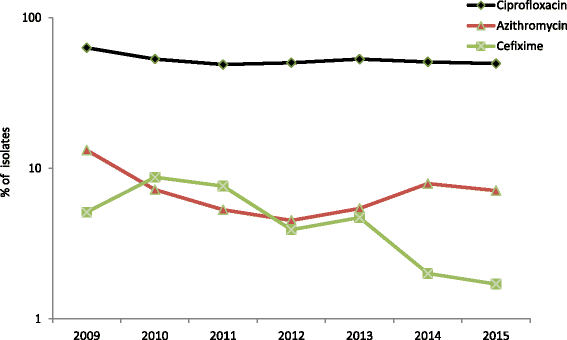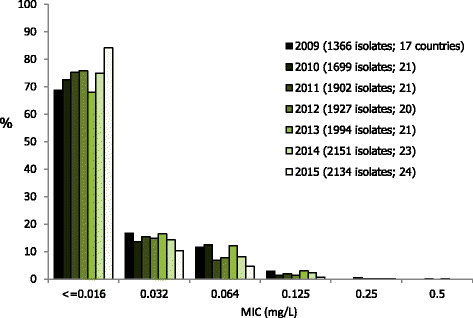Overall Low Extended-Spectrum Cephalosporin Resistance but high Azithromycin Resistance in Neisseria gonorrhoeae in 24 European Countries, 2015
- PMID: 28893203
- PMCID: PMC5594611
- DOI: 10.1186/s12879-017-2707-z
Overall Low Extended-Spectrum Cephalosporin Resistance but high Azithromycin Resistance in Neisseria gonorrhoeae in 24 European Countries, 2015
Abstract
Background: Surveillance of Neisseria gonorrhoeae antimicrobial susceptibility in Europe is performed through the European Gonococcal Antimicrobial Surveillance Programme (Euro-GASP), which additionally provides data to inform the European gonorrhoea treatment guideline; currently recommending ceftriaxone 500 mg plus azithromycin 2 g as first-line therapy. We present antimicrobial susceptibility data from 24 European countries in 2015, linked to epidemiological data of patients, and compare the results to Euro-GASP data from previous years.
Methods: Antimicrobial susceptibility testing by MIC gradient strips or agar dilution methodology was performed on 2134 N. gonorrhoeae isolates and interpreted using EUCAST breakpoints. Patient variables associated with resistance were established using logistic regression to estimate odds ratios (ORs).
Results: In 2015, 1.7% of isolates were cefixime resistant compared to 2.0% in 2014. Ceftriaxone resistance was detected in only one (0.05%) isolate in 2015, compared with five (0.2%) in 2014. Azithromycin resistance was detected in 7.1% of isolates in 2015 (7.9% in 2014), and five (0.2%) isolates displayed high-level azithromycin resistance (MIC ≥ 256 mg/L) compared with one (0.05%) in 2014. Ciprofloxacin resistance remained high (49.4%, vs. 50.7% in 2014). Cefixime resistance significantly increased among heterosexual males (4.1% vs. 1.7% in 2014), which was mainly attributable to data from two countries with high cefixime resistance (~11%), however rates among men-who-have-sex-with-men (MSM) and females continued to decline to 0.5% and 1%, respectively. Azithromycin resistance in MSM and heterosexual males was higher (both 8.1%) than in females (4.9% vs. 2.2% in 2014). The association between azithromycin resistance and previous gonorrhoea infection, observed in 2014, continued in 2015 (OR 2.1, CI 1.2-3.5, p < 0.01).
Conclusions: The 2015 Euro-GASP sentinel system revealed high, but stable azithromycin resistance and low overall resistance to ceftriaxone and cefixime. The low cephalosporin resistance may be attributable to the effectiveness of the currently recommended first-line dual antimicrobial therapy; however the high azithromycin resistance threatens the effectiveness of this therapeutic regimen. Whether the global use of azithromycin in mono- or dual antimicrobial therapy of gonorrhoea is contributing to the global increases in azithromycin resistance remains to be elucidated. The increasing cefixime resistance in heterosexual males also needs close monitoring.
Keywords: Antimicrobial resistance; Ceftriaxone; Europe; European Economic Area (EEA); European Gonococcal Antimicrobial Surveillance Programme (Euro-GASP); European Union (EU); Gonorrhoea; Surveillance; Treatment.
Conflict of interest statement
Ethics approval and consent to participate
All examined gonococcal isolates were cultured and preserved as part of the routine diagnostics (standard care), and isolates or data were submitted to the Euro-GASP surveillance study with no patient identification information. Ethical approval was therefore not required.
Consent for publication
Not applicable.
Competing interests
The authors declare that they have no competing interests.
Publisher’s Note
Springer Nature remains neutral with regard to jurisdictional claims in published maps and institutional affiliations.
Figures



References
-
- World Health Organisation. Global action plan to control the spread and impact of antimicrobial resistance in Neisseria gonorrhoeae. 2012. http://whqlibdoc.who.int/publications/2012/9789241503501_eng.pdf. Accessed 02 Aug 2017.
-
- European Centre for Disease Prevention and Control. Response plan to control and manage the threat of multidrug-resistant gonorrhoea in Europe. 2012. http://www.ecdc.europa.eu/en/publications/Publications/1206-ECDC-MDR-gon.... Accessed 02 Aug 2017.
-
- European Centre for Disease Prevention and Control. Gonococcal antimicrobial susceptibility surveillance in Europe 2014. 2016. http://ecdc.europa.eu/en/publications/Publications/gonococcal-antimicrob.... Accessed 02 Aug 2017.
MeSH terms
Substances
LinkOut - more resources
Full Text Sources
Other Literature Sources
Medical

